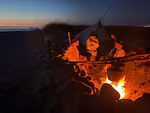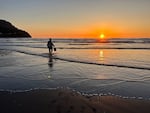Salt. Seems simple, right?
Common on just about any restaurant table or grocery store shelf. Probably even in your own kitchen cabinet. And yet, such simple grains of salt have a long history, from ancient times to today.
Here in Oregon, two groups on the coast are trying to unlock the secret of making pure, clean, edible salt from sea water. One is a modern company that has gained a reputation with foodies for its delicate sea salt flakes. The other group is dressed in buckskin and wool, tending a copper-lined kettle over a campfire, making a concerted effort to time travel back to the winter of 1805.
For both, the basic process is straightforward: Take water from the ocean; boil it down; repeat; repeat; repeat.
But both the artisans of the modern salt-harvesting factory and the history reenactors have learned that the process is not always so simple. They’ve had to learn to perfect the process of making salt through trial and error.
Stepping back in time to make salt
In 1805, the Lewis and Clark Corps of Discovery had finally arrived at their destination on the Oregon Coast. Cold, wet, beleaguered by the journey, they had run low on an essential provision: salt.
Captain Meriwether Lewis dispatched a few of the men to head to the ocean and replenish the material they needed not only to flavor, but to preserve their food.
The men spent a couple rainy months tending a campfire and boiling down seawater. They returned with what Captain Lewis recorded in his journal as “excellent, fine, strong and white salt.”

Members of the Pacific Northwest Living Historians boil seawater over a campfire during the annual Lewis and Clark salt making reenactment in Seaside, Ore., in September 2023.
Ian McCluskey / OPB
But without detailed historic records of how the original Corps of Discovery made salt, reenactors of this event have to rely on trial and error.
“Most people would figure, which I did, was you get seawater and you boil it down and then you get salt from it. Right?” said Glen Allison, a reenactor with the Pacific Northwest Living Historians. “But it turns out there are more processes you need to go through to really get what you want.”
The reenactors gather at the south end of the beach in Seaside, Oregon, every Labor Day weekend. They pitch a small camp in the dunes, along the path to the beach. Passersby stop to ask them what they are doing. The reenactors, dressed in homemade period clothing, happily regale tourists with the story of what is likely the first recorded account of salt-making on the Oregon Coast. Over the course of the weekend event, they suspend buckets over a crackling campfire.
When they first tried to make salt, it came out a greenish gray color. Then they realized the discoloration could have come from the patina of their copper-lined kettles.
“It helps to clean your pot,” Allison said.
The reenactors have pushed the beach sand into a U-shaped berm. This helps block the wind and radiate the heat. They need a hot fire to keep the kettles of salt water at a simmer. But not so hot that the leaping flames char and even burn through the peeled logs suspending the pots.
If the green discoloration came from the copper, the gray color might have come from the smoke and ash.

A member of the Pacific Northwest Living Historians fetches a bucket of seawater from the ocean.
Ian McCluskey / OPB
They tried wrapping the poles in buckskin to prevent the charring, then ladling water to try to keep the poles from catching fire. They watch the fire in shifts, even through the night.
Since the building of jetties, the Seaside beach has grown longer and wider. What was once likely a rocky shoreline is now a rolling strip of dunes. At the site where it’s believed the Corps of Discovery made the salt is a long rock structure, like a long pizza oven with the kettles set on top. Perhaps that helped prevent burned poles and floating ash.
The reenactors take turns fetching water from the ocean. They carry two buckets at a time with the aid of a heavy wooden yoke. As they walk in their moccasins waist-deep into the surf alongside kids with boogie boards, the scene is incongruous.
But at dusk, the crowds thin out. For the most part, the beach is empty. There is just the sound of the surf crashing. The scent of the wood smoke and ocean brine in the air. They gather by their fire and poke at it, sending embers twining. In this moment, all the trappings of the modern world retreat into the shadows, and they are left with just the basics — as close to time travel as they can get, feeling the camaraderie of the salt-making camp.
Modern salt makers
South of Seaside in Netarts Bay, the workers of the Jacobsen Salt Co. have taken the basic salt-making process and brought it into the 21st century.
To make salt at a commercial level necessitates increasing the speed and volume. But it is still a hands-on, time-intensive process.
Related: Congress passes legislation to study Oregon’s Lake Abert and other saline lakes
When the company started, founder Ben Jacobsen scooped a plastic 5-gallon bucket into the bay to collect seawater — not unlike the reenactors. Today, a pipe pumps seawater at high tide into holding tanks. Then the water is sent through a process that might make Meriwether Lewis’ head spin: reverse osmosis.
Reverse osmosis is a filtration process to separate clean, drinkable water from seawater, also known as desalinization. But in this situation, they reverse the process, making the clean water the byproduct, channeling the extra salty water, or “pre-brine,” into large cauldrons.
These cauldrons steam around the clock, slowly reducing the water to a brine.
The brine is then moved to large, open stainless steel tables, heated underneath by propane jets. The seawater that had started at about 3% salinity is now 28%, the point at which it begins to crystalize.
Salt harvested from seawater has long been produced on the coasts of France, Portugal and Spain, at facilities in Guérande and Île de Ré on the west coast of France, and salt works on the coast of Portugal and Spain.
The crystals that form, floating on the surface of the salt-saturated brine, got the name “fleur de sel” in French or “flor de sal” in Spanish, which translates to “flower of salt.”

Amanda Batten, post-production lead for Jacobsen Salt Co., explains the final stages of the salt-making process in September 2023.
Stephani Gordon / OPB
When the pyramid-like crystals become too heavy for the surface tension of the water’s surface, they begin to fall.
“It starts essentially snowing into the pan,” said Jason Hovey, Jacobsen Salt Co.’s lead of operations.
The salt crystals are gingerly scooped from the tables, washed, dried, sorted by size and bagged. It takes about two weeks for the salt to go from “bay to bag.”
Today, fancy salt is a luxury and the delight of food aficionados. Sodium also stimulates the sensors in the taste buds, so they are more sensitive to flavors in food. Without salt, subtle flavors can go undetected. At the same time, salt mutes bitter flavors, often making sweeter tastes more noticeable. Greens are often salted to cut their natural bitter taste. Interestingly, the English word “salad” comes from the Latin term for salted, “salata.”
Jacobsen Salt Co. has been experimenting with infusion flavors, such as black garlic and rosemary, and even habanero.
“If Lewis and Clark could see this, their minds would be blown,” said Tim Roberds, the company’s lead salt maker.
Related: ‘The Four Top’: Ben Jacobsen | Kristofor Lofgren
Yet, despite the advancement in technology, he said, the switch from open campfire to factory-sized boiling tanks, the process remains essentially the same.
“It’s still a primal process. We’re still using flame to heat up water,” Roberds said. “We might change our heat source, but it’s still heat to water to evaporation. That’s very primal. I don’t think that will ever change.”
But for both the reenactors and the modern salt makers, there is always room for improvement. Whether by timing or temperature or technique, they will continue to test and tinker, in a quest to unlock the subtlety of simple sea salt.
